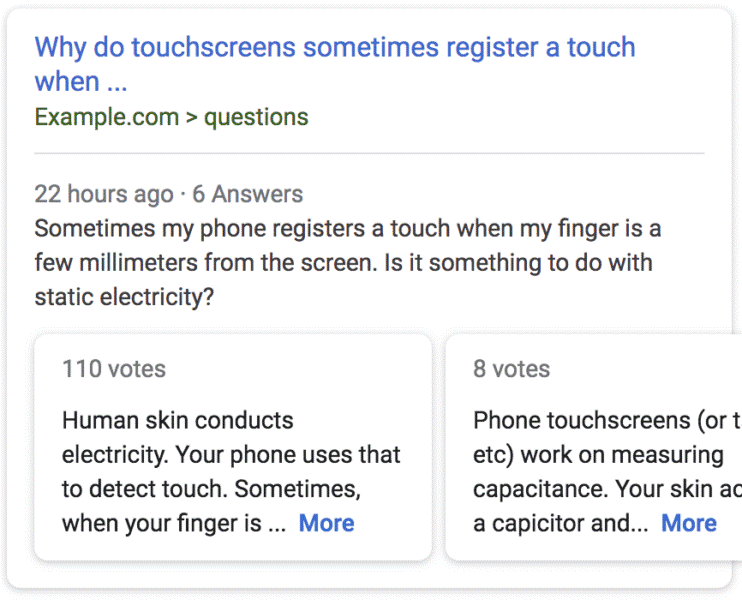The field of SEO encompasses a wide range of disciplines and actions that we carry out with one objective: to increase the capture of organic quality traffic from a website through the improvement of its positioning.
Among all the aspects that we can work within an SEO strategy, On-page and Off-page, there are some with greater and others with less impact on the ranking of positions of a website. One of the ones that are giving more talk in recent months (although it has been more than 10 years since Google announced its introduction in the SERPs) are the Rich Snippets. Since they have evolved over time and Google periodically introduces news in them, we will analyse the current status of the Rich Snippets, defining what they are, their influence on the positioning, what types we can use on our website and a long etc. of issues related to enriched fragments.
What Are Rich Snippets or Enriched Results?
By default, when we perform a Google search, each of the organic results (leaving out ads and results of the Local pack) are made up of a title, a URL and a description. For many years, this was the standard aspect of the results for most pages present in Google SERPs.
For some time now, Google began to show more elements associated with the snippets of the websites, such as a prominent image, the date of publication or the price of a product. In this way, it “enriched” the visual aspect of the search results, and baptized these improvements as Rich Snippets or enriched results.
As we mentioned above, the variety of improvements introduced in snippets has been increasing over the years, with some available for any type of page and others specific for some content.
But where does Google extract the information to generate these Rich Snippets? To answer this question, we must first explain what is Schema.
What is Schema and what is Its Relationship with Google’s Rich Snippets?
Schema is a collaborative project that aims to create a standard in data marking that allows to better categorize the information available on the Internet. To do this, it defines entities that represent elements of the real world and their relationships between them.
One of the main purposes of this initiative is to provide search engines with a better understanding of web content. Since the marking of Schema data specifies what element or elements we are defining on a web page, Google, Bing and other search engine tracking bots will be able to understand and classify this information more easily. And, in the case of Google, use it to generate the Rich Snippets.
For example, if we have a business with several branches in different locations, it will be common for us to have a page on our website to list such subsidiaries. If, in addition, we include data marking with Schema to this page, we will be able to explain the data of each branch (location, contact information, etc.) and its relationship with the main brand.
It should be noted that Google only uses a small part of the Schema specification for its Rich Snippets. So not all data marking with Schema of a website will result in a rich Google result.
What Benefits to Do Rich Snippets Bring to a Website?
In general, the Rich Snippets provide a visual improvement over the traditional result of the SERPs. In many cases, allowing us to stand out against other results of the competition.
In this sense, an enriched result should be more attractive to users compared to other normal results and cause an increase in our organic search CTR. The reality is that it will depend on each case.
Think, for example, of entering structured data for product listings of e-commerce. In these cases, Google can choose to directly display the price or rating of the same in the enriched result. If the first does not match the user’s expectations or the second is negative, the presence of this information on the results page can cause rejection.
On the other hand, beyond the visual improvement of the snippet, incorporating structured data into a website will allow us, as we mentioned above, to facilitate the task of classifying information to search engines.
Do Rich Snippets Serve to Improve SEO?
As in many aspects related to SEO, the answer to this question will depend. On the one hand, the improvement of the visual aspect of our result in SERPs can translate into an increase in CTR. In practice, this means that with the same number of organic impressions, we will get more clicks, increasing SEO traffic to our website.
On the other hand, Google has not specified that the presence of Schema marking is a positioning signal.
Types of Rich Snippets That Google Allows
Leaving aside elements of SERPs that do not depend directly on the presence of data marking with Schema on our website (for example, result 0), we can classify the Rich Snippets allowed by Google into two types:
Linked to the business and the entire web.
Specific contents.
The first ones refer to the possibility of specifying, through data marking, aspects such as information about our company (logo, social profiles, contact actions …), and breadcrumbs for all pages of the site or the internal search engine.
The latter are those that describe specific contents of each of the pages of our website, providing additional information in the SERP. The list of those accepted by Google is currently as follows:
Article
Local company
Multimedia actions
Recipe
Critic Reviews
Video
Book
Carousels
Course
job
Event
Data verification
Live broadcast
Local business
Product
Question pages (for example, forums)
Opinions
App
Paid content
FAQs
How to
The list has been growing over time. You can check the official Google documentation here
Some Examples of Rich Snippets
To illustrate how rich results are displayed on the Google results page, here are some examples of Rich Snippets:
Product
Breadcrumb
Question Pages
How to Implement Rich Snippets on a Web?
Google offers three options to add the Schema mark-up accepted for Rich Snippets on a website:
JSON-LD
Microdata
RDFa
The first, JSON-LD, is recommended by Google. It allows to incorporate this information in JSON format, so we can add the corresponding code block without altering our HTM L tags.
The second and third, Micro data and RDFa, imply the modification of the HTML tags that surround the information. In these cases, we must modify the HTML code.
In any case, we must follow the specifications for each type of Rich Snippets and the general recommendations of Google.
How to try the Rich Snippets?
Once added to our website, we can verify if we have implemented the Rich Snippets correctly. To do this, we have the Tool Structured Data Testing of Google to validate our code.
We can also check in the Search Console if Google is correctly identifying the data marking of our website and detect problems with its implementation.
Rich Snippets are a very attractive functionality for most websites that have organic traffic as a source of visitor visits. If you have questions about them or need help to incorporate them into your website, do not hesitate to contact us.



